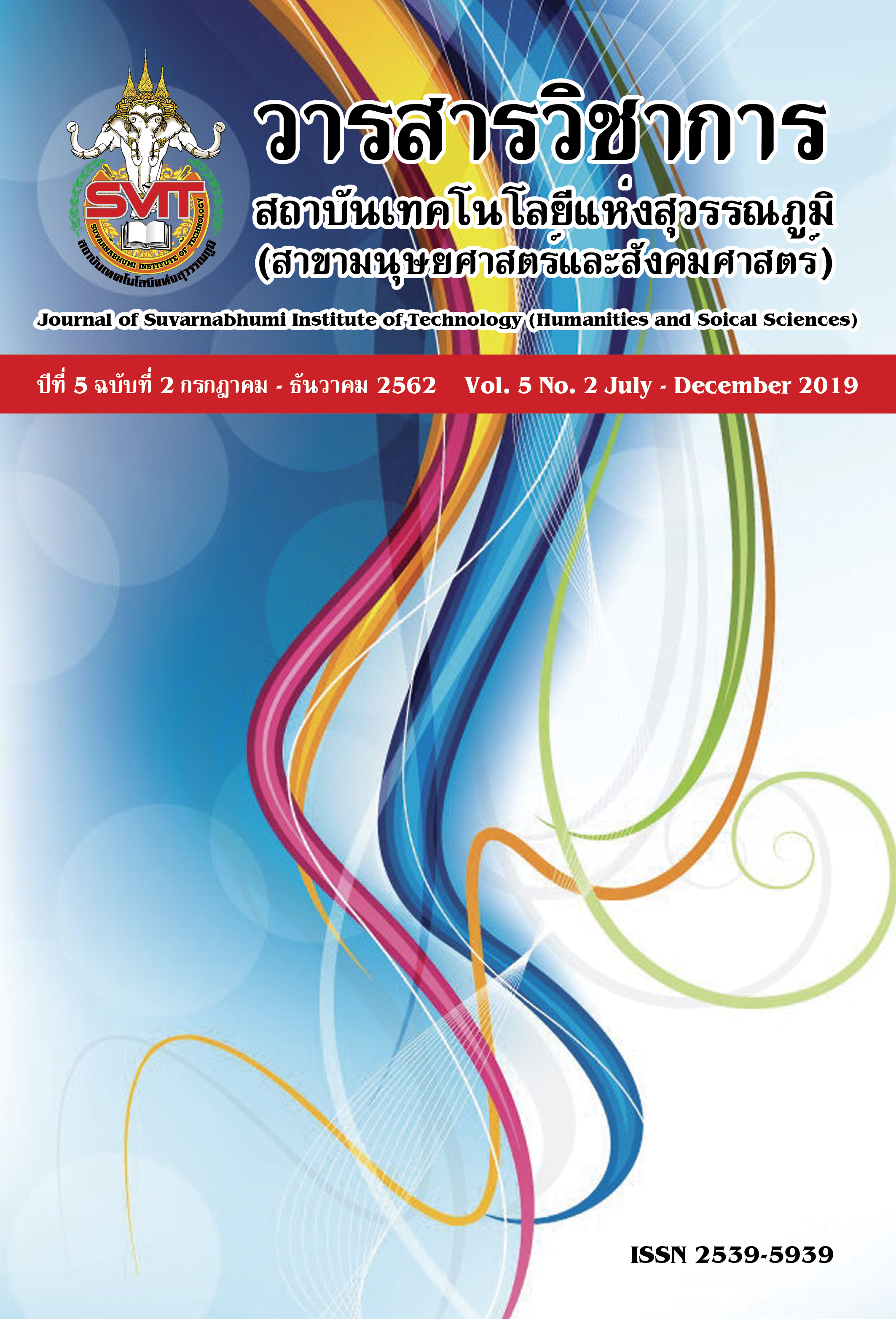การพัฒนาบางด้วนโมเดลในการส่งเสริมพฤติกรรมสุขภาพของผู้ป่วยเบาหวานชนิดที่ 2 ตำบลบางด้วน อำเภอเมืองสมุทรปราการ จังหวัดสมุทรปราการ
คำสำคัญ:
บางด้วนโมเดลส่งเสริมพฤติกรรมสุขภาพ, การสนับสนุนทางสังคม, ผู้ป่วยเบาหวานชนิดที่ 2, 3อ.2ส.บทคัดย่อ
การศึกษาเรื่อง “การพัฒนาบางด้วนโมเดลในการส่งเสริมพฤติกรรมสุขภาพของผู้ป่วยเบาหวานชนิดที่ 2 ตำบลบางด้วน อำเภอเมืองสมุทรปราการ จังหวัดสมุทรปราการ” มีวัตถุประสงค์ 1) เพื่อพัฒนารูปแบบบางด้วนโมเดลในการดูแลพฤติกรรมสุขภาพของผู้ป่วยเบาหวานชนิดที่ 2 2) เพื่อศึกษาผลของรูปแบบบางด้วนโมเดลในการส่งเสริมพฤติกรรมสุขภาพของการควบคุมระดับน้ำตาลในเลือดของผู้ป่วยโรคเบาหวานชนิดที่ 2 ก่อนและหลังการพัฒนา 3) เพื่อเปรียบเทียบความรู้ ทัศนคติ และการปฏิบัติตนด้านแบบแผนการดำเนินชีวิต ตามหลัก 3อ.2ส. ก่อนและหลังดำเนินการ
การศึกษาในครั้งนี้เป็นการวิจัยกึ่งทดลอง กลุ่มตัวอย่างเป็นผู้ป่วยเบาหวานชนิดที่ 2 จำนวน 66 คน แบ่งเป็น 2 กลุ่มคือ กลุ่มทดลองใช้รูปแบบบางด้วนโมเดลส่งเสริมสุขภาพตามแนวคิดแบบแผนความเชื่อทางสุขภาพ จำนวน 33 คน และกลุ่มเปรียบเทียบไม่ได้รับโปรแกรมส่งเสริมสุขภาพ จำนวน 33 คน เครื่องมือที่ใช้ในการทดลอง คือ โปรแกรมบางด้วนโมเดลส่งเสริมสุขภาพ ซึ่งใช้เวลาในการทดลอง
12 สัปดาห์ มีดัชนีความสอดคล้องเท่ากับ 0.93 เครื่องมือที่ใช้ในการเก็บรวบรวมข้อมูลคือ แบบประเมินความรู้เกี่ยวกับโรคเบาหวาน การสนับสนุนทางสังคมและพฤติกรรมการควบคุมระดับน้ำตาลในเลือดโดยใช้หลัก 3อ.2ส.ที่ มีค่าความเที่ยงเท่ากับ 0.86, 0.72 และ 0.70 วิเคราะห์ข้อมูลโดยการหาค่าเฉลี่ย
ส่วนเบี่ยงเบนมาตรฐาน และค่าที (t-test)
ผลการวิจัย พบว่า 1) รูปแบบโปรแกรมบางด้วนโมเดลในการส่งเสริมสุขภาพที่พัฒนาขึ้นตามแนวคิดแบบแผนความเชื่อทางสุขภาพ ประกอบด้วยการให้ความรู้ การสนับสนุนทางสังคม และการปฏิบัติ 3อ.2ส. มีกระบวนการจัดการเรียนรู้ 8 กิจกรรม และการประเมินผล 2) และ 3) ผลของการใช้โปรแกรม
บางด้วนโมเดลในการส่งเสริมสุขภาพตามแนวคิดแบบแผนความเชื่อทางสุขภาพ พบว่า ค่าเฉลี่ยของระดับน้ำตาลในเลือด Fasting Blood Sugar และค่าระดับน้ำตาลสะสม HbA1c ของกลุ่มทดลองหลังการทดลองต่ำกว่าก่อนการทดลองอย่างมีนัยสำคัญทางสถิติที่ระดับ .05 และต่ำกว่ากลุ่มเปรียบเทียบที่ไม่ได้รับโปรแกรมส่งเสริมสุขภาพ อย่างมีนัยสำคัญทางสถิติที่ระดับ .05
เอกสารอ้างอิง
ธาริน สุขอนันต์, ณัฐพร มีสุข และ อาภิสรา วงศ์สละ.(2559).ปัจจัยที่มีผลต่อพฤติกรรมการควบคุมระดับน้ำตาลในเลือดของผู้ป่วยเบาหวานโรงพยาบาลส่งเสริมสุขภาพตำบลบ้านสวนอำเภอเมืองจังหวัดชลบุรี. วารสารวิทยาลัยพยาบาลพระปกเกล้าจันทบุรีปีที่ 27 ฉบับที่ 1 กันยายน 2558 - กุมภาพันธ์ 2559. หน้า 93-102.
โรงพยาบาลส่งเสริมสุขภาพตำบลบางด้วน. (2559). รายงานผลการปฏิบัติงานประจำปี 2559. สมุทรปราการ. หน้า 17-58.
โรงพยาบาลส่งเสริมสุขภาพตำบลบางด้วน. (2560). ทะเบียนผู้ป่วยโรคเบาหวาน ปีงบประมาณ 2560. สมุทรปราการ. หน้า 2-24.
Krejcie, R. V. & Morgan, D. W. (1970). Determining Sample Size for Research Activities. Educational and Psychological Measurement, 30(3), pp. 607-610.
Kobayashi A.(2008). Launch of a National Mandatory Chronic Disease Prevention Program in Japan. Disease Management & Health Outcomes.16(4):217-225.
Nolte, E; Knai, C (2015). Assessing chronic disease management in European health systems. Country reports. Technical Report. World Health Organization, Copenhagen, Denmark.
Wilson, T.D. (2000). “Human information behavior.” Informing Science. 3(2), 49-55. Retrieved 1 October, 2010. from https://inform.nu/ Articles/Vol3/v3n2p49-56.pdf
World Bank. (2011). The World Bank Annual Report 2011:Year in Review. Washington, DC. Retrieved from https://openknowledge.worldbank.org/handle/10986/2378
World Health Organization. (2013). Global action plan for the prevention and control of noncommunicable diseases 2013-2020. Geneva: World Health Organization.
ดาวน์โหลด
เผยแพร่แล้ว
ฉบับ
ประเภทบทความ
สัญญาอนุญาต
บทความที่ได้รับการตีพิมพ์เป็นลิขสิทธิ์ของวารสารวิชาการ สถาบันเทคโนโลยีแห่งสุวรรณภูมิ
ข้อความที่ปรากฏในบทความแต่ละเรื่องในวารสารวิชาการเล่มนี้เป็นความคิดเห็นส่วนตัวของผู้เขียนแต่ละท่านไม่เกี่ยวข้องกับสถาบันเทคโนโลยีแห่งสุวรรณภูมิ และคณาจารย์ท่านอื่นๆในสถาบันฯ แต่อย่างใด ความรับผิดชอบองค์ประกอบทั้งหมดของบทความแต่ละเรื่องเป็นของผู้เขียนแต่ละท่าน หากมีความผิดพลาดใดๆ ผู้เขียนแต่ละท่านจะรับผิดชอบบทความของตนเองแต่ผู้เดียว





